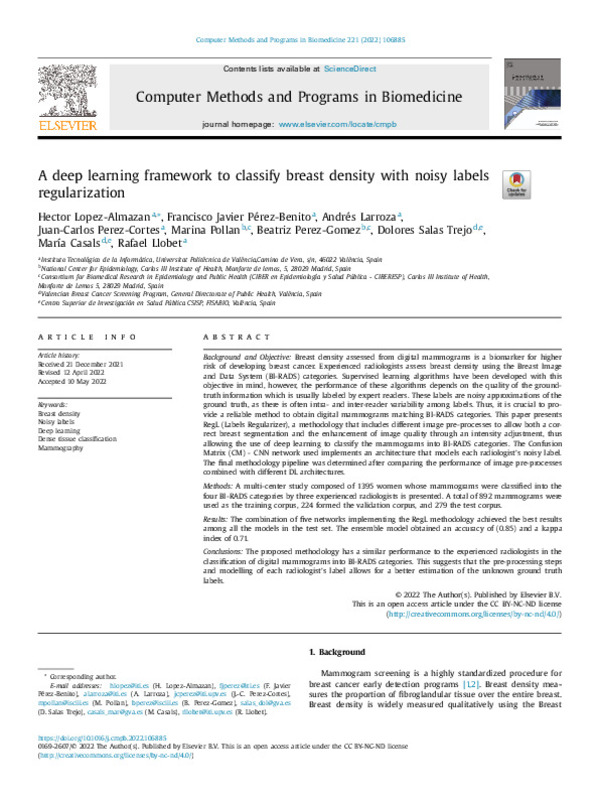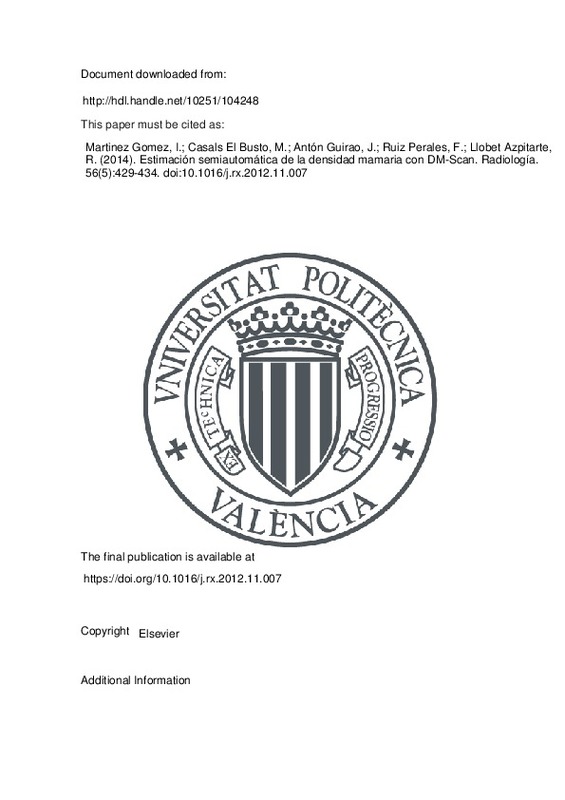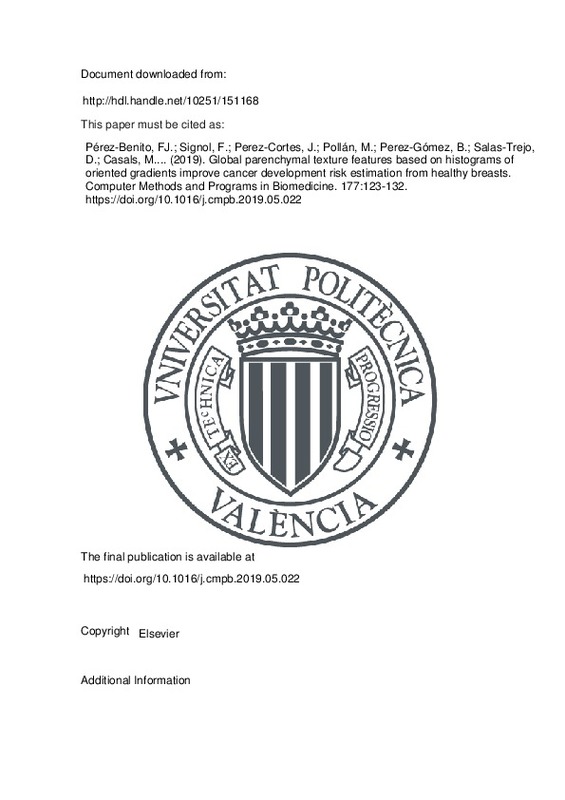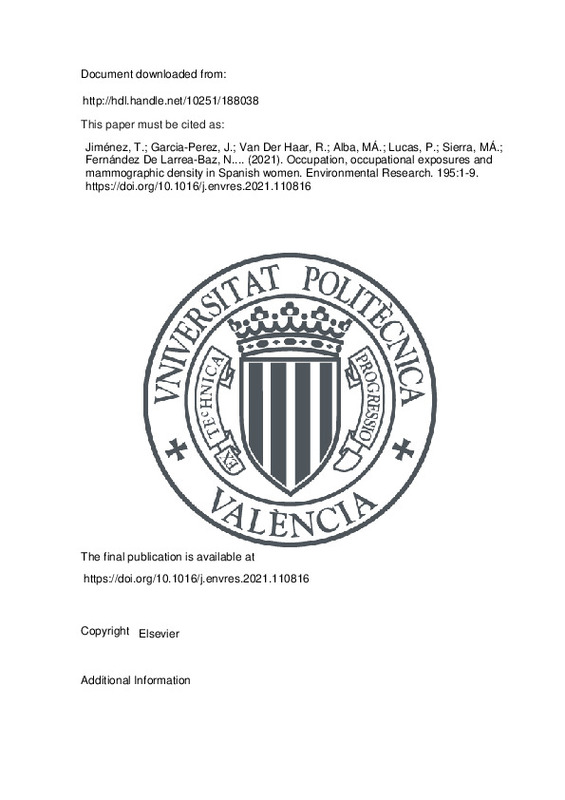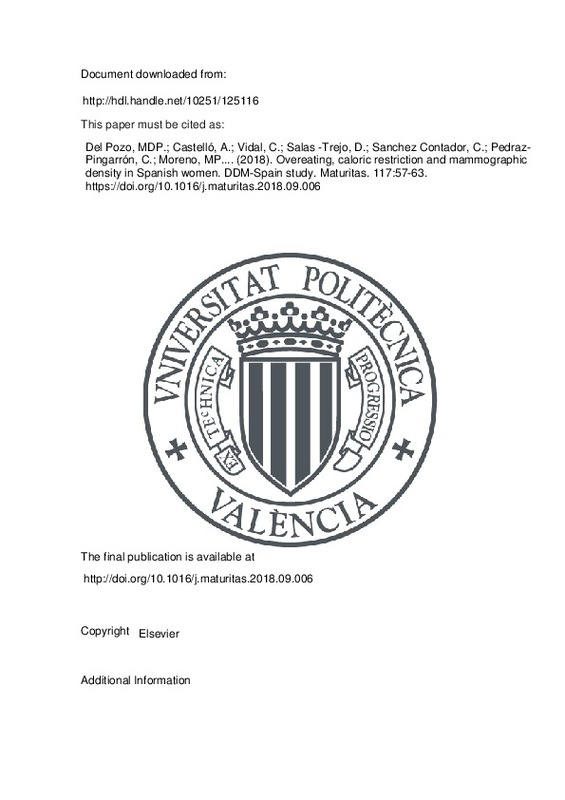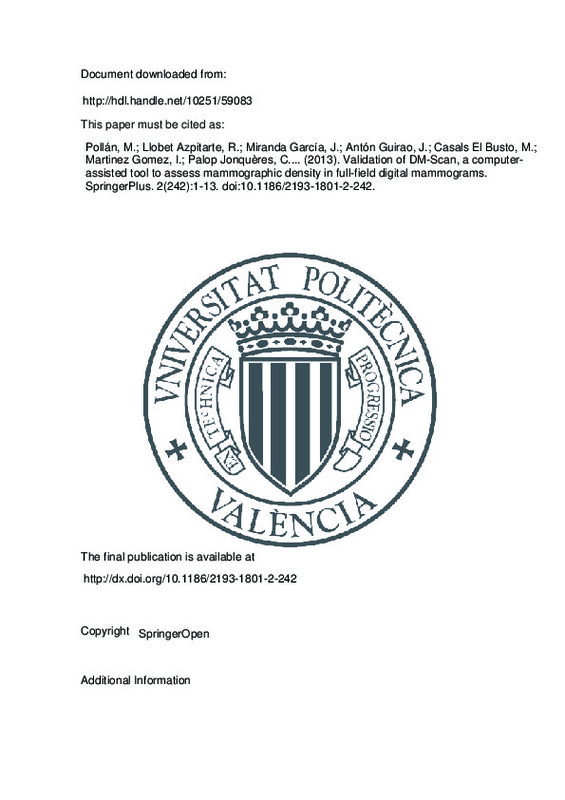

Listar por palabra clave "Breast density"
RiuNet: Repositorio Institucional de la Universidad Politécnica de Valencia
- RiuNet repositorio UPV
- :
- Listar por palabra clave
JavaScript is disabled for your browser. Some features of this site may not work without it.
Buscar en RiuNet
Listar
Mi cuenta
Ayuda RiuNet
Admin. UPV
Listar por palabra clave "Breast density"
Mostrando ítems 1-12 de 12
-
López-Almazán, Héctor; Perez-Benito, Francisco Javier; Larroza, Andrés; Perez-Cortes, Juan-Carlos; Pollán, Marina; Perez-Gomez, Beatriz; Salas-Trejo, Dolores; Casals, María; Llobet Azpitarte, Rafael (Elsevier, 2022-06-01)[EN] Background and Objective: Breast density assessed from digital mammograms is a biomarker for higher risk of developing breast cancer. Experienced radiologists assess breast density using the Breast Image and Data ...
-
Perez-Benito, Francisco Javier; Signol, François; Perez-Cortes, Juan-Carlos; Fuster Bagetto, Alejandro; Pollan, Marina; Pérez-Gómez, Beatriz; Salas-Trejo, Dolores; Casals, Maria; Martínez, Inmaculada; Llobet Azpitarte, Rafael (Elsevier, 2020-10)[EN] Background and Objective: Breast cancer is the most frequent cancer in women. The Spanish healthcare network established population-based screening programs in all Autonomous Communities, where mammograms of asymptomatic ...
-
Díaz Sydorenko, Karina (Universitat Politècnica de València, 2023-09-26)[ES] La densidad mamaria es uno de los factores de riesgo del cáncer de mama, y depende directamente de la cantidad de tejido fibroglandular en proporción al tejido adiposo existente en la mama. En algunos casos, el ...
-
Tendero Alarcón, Raquel (Universitat Politècnica de València, 2023-09-14)[ES] El cáncer que produce el mayor número de muertes en la población femenina es el de mama debido a su gran incidencia. La detección temprana de la enfermedad es vital para la aplicación de un tratamiento a tiempo, que ...
-
Martinez Gomez, Inmaculada; Casals el Busto, María; Antón Guirao, Joaquín; Ruiz Perales, Francisco; Llobet Azpitarte, Rafael (Elsevier, 2014)[EN] Objective To evaluate the reproducibility of the calculation of breast density with DM-Scan software, which is based on the semiautomatic segmentation of fibroglandular tissue, and to compare it with the reproducibility ...
-
Pérez-Benito, Francisco Javier; Signol, François; Perez-Cortes, Juan-Carlos; Pollán, Marina; Perez-Gómez, Beatriz; Salas-Trejo, Dolores; Casals, María; Martinez, Inmaculada; Llobet Azpitarte, Rafael (Elsevier, 2019-08)[EN] Background The breast dense tissue percentage on digital mammograms is one of the most commonly used markers for breast cancer risk estimation. Geometric features of dense tissue over the breast and the presence of ...
-
Pérez Argilés, Pilar (Universitat Politècnica de València, 2023-09-27)[ES] Este TFG se centra en los desafíos actuales de la investigación del cáncer de mama, especialmente en el contexto de datos de alta dimensionalidad. El objetivo principal es explorar la relación entre los polimorfismos ...
-
Jiménez, Tamara; Garcia-Perez, Javier; van der Haar, Rudolf; Alba, Miguel Ángel; Lucas, Pilar; Sierra, María Ángeles; Fernández de Larrea-Baz, Nerea; Salas-Trejo, Dolores; Llobet Azpitarte, Rafael; Martínez, Inmaculada; Pino, María Nieves; Alguacil, Juan; González-Galarzo, Mª Carmen; Martínez-Cortés, Mercedes; Pérez-Gómez, Beatriz; Pollán, Marina; Lope, Virginia (Elsevier, 2021-04)[EN] Introduction: Mammographic density (MD), the proportion of radiologically dense breast tissue, is a strong risk factor for breast cancer. Our objective is to investigate the influence of occupations and occupational ...
-
del Pozo, Maria del Pilar; Castelló, Adela; Vidal, Carmen; Salas -Trejo, Dolores; Sanchez Contador, Carmen; Pedraz-Pingarrón, Carmen; Moreno, María Pilar; Santamariña, Carmen; Ederra, María; Llobet Azpitarte, Rafael; Vioque, Jesús; Perez Gómez, Beatriz; Pollán, Marina; Lope, Virginia (Elsevier, 2018)[EN] Objectives: Mammographic density (MD) is a strong risk factor for breast cancer. The present study evaluates the association between relative caloric intake and MD in Spanish women. Study design: We conducted a ...
-
Jiménez, Tamara; Domínguez-Castillo, Alejandro; Fernandez de Larrea-Baz, Nerea; Lucas, Pilar; Sierra, María Ángeles; Salas -Trejo, Dolores; Llobet Azpitarte, Rafael; Martínez, Inmaculada; Pino, Marina Nieves; Martínez-Cortés, Mercedes; Perez Gómez, Beatriz; Pollán, Marina; Lope, Virginia; García-Pérez, Javier (Elsevier, 2024-06-10)[EN] Background Mammographic density (MD) is the most important breast cancer biomarker. Ambient pollution is a carcinogen, and its relationship with MD is unclear. This study aims to explore the association between exposure ...
-
Lope, Virginia; del Pilar del Pozo, Maria; Criado-Navarro, Inmaculada; Pérez-Gómez, Beatriz; Pastor-Barriuso, Roberto; Ruiz, Emma; Castelló, Adela; Lucas, Pilar; Sierra, Ángeles; Salas-Trejo, Dolores; Llobet Azpitarte, Rafael; Martínez, Inmaculada; Romieu, Isabelle; Chajès, Véronique; Priego-Capote, Feliciano; Pollán, Marina (American Society for Nutrition, 2020-09-01)[EN] Background: The role of fatty acids (FAs) on mammographic density (MD) is unclear, and available studies are based on self-reported dietary intake. Objectives: This study assessed the association between specific ...
-
Pollán, Marina; Llobet Azpitarte, Rafael; Miranda García, Josefa; Antón Guirao, Joaquín; Casals el Busto, María; Martinez Gomez, Inmaculada; Palop Jonquères, Carmen; Ruiz Perales, Francisco; Sanchez Contador, Carmen; Vidal, Carmen; Perez Gómez, Beatriz; Salas Trejo, Dolores (SpringerOpen, 2013)We developed a semi-automated tool to assess mammographic density (MD), a phenotype risk marker for breast cancer (BC), in full-field digital images and evaluated its performance testing its reproducibility, comparing our ...
Mostrando ítems 1-12 de 12

Universitat Politècnica de València. Unidad de Documentación Científica de la Biblioteca (+34) 96 387 70 85 · RiuNet@bib.upv.es


